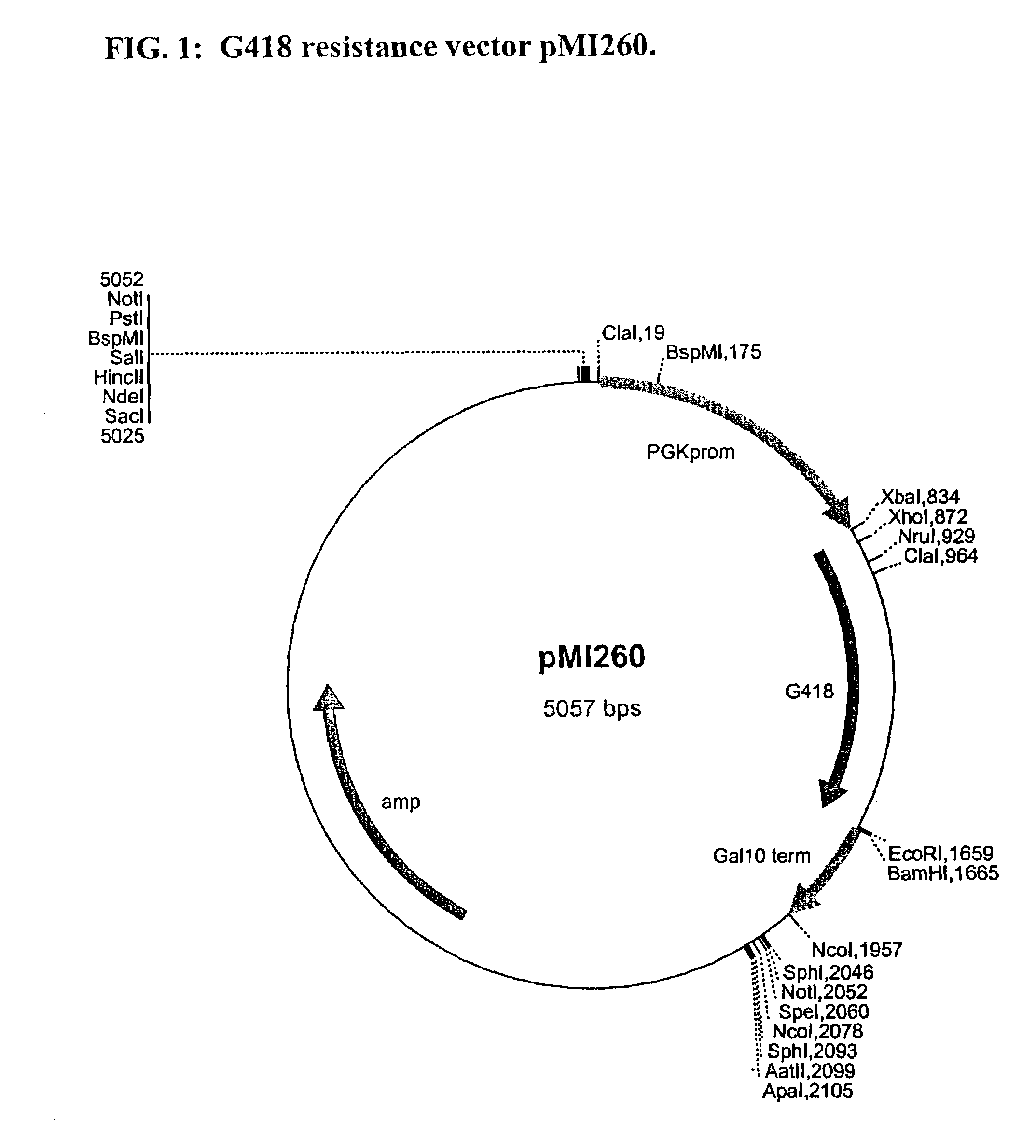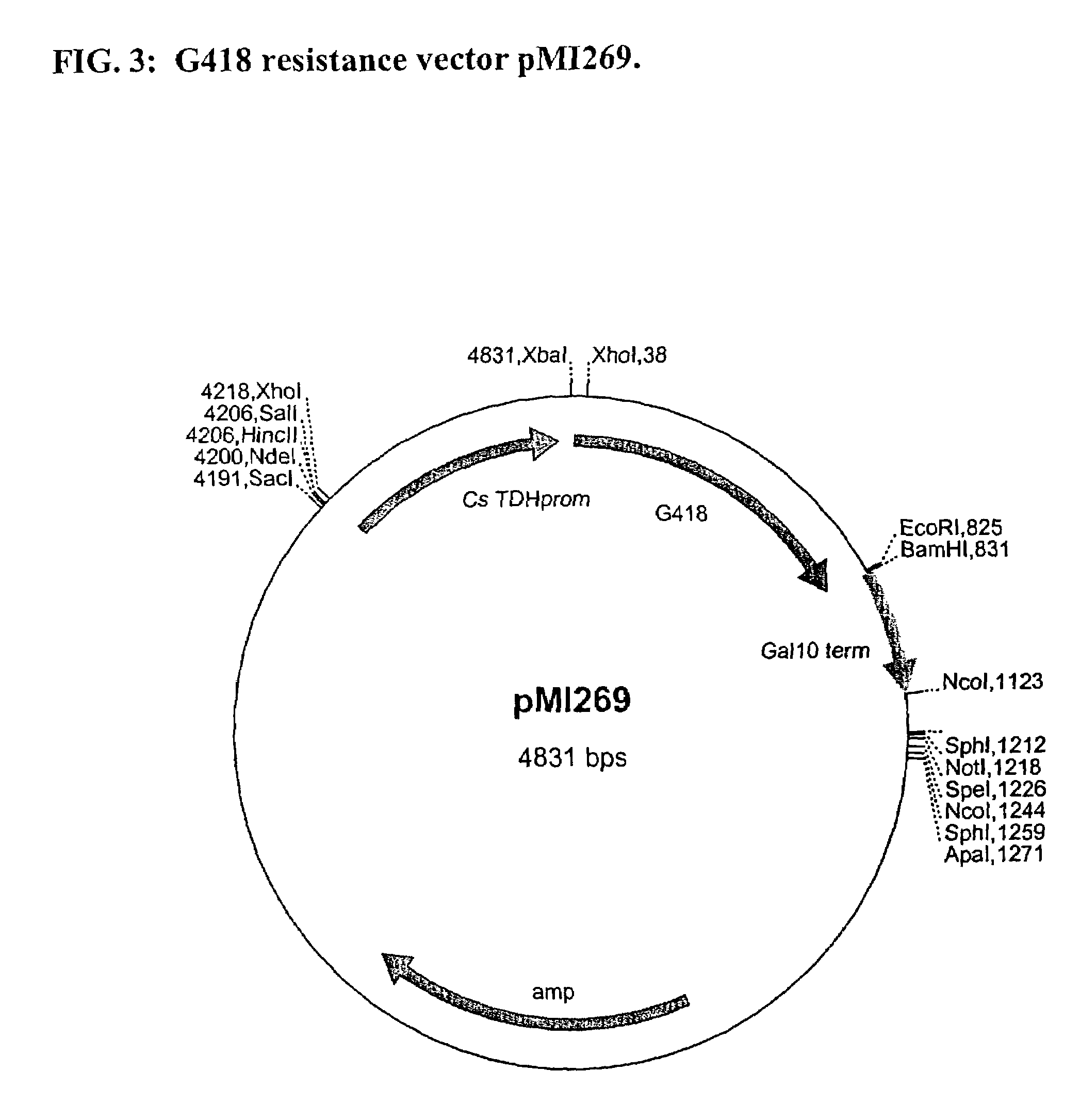Methods and materials for the production of organic products in cells of Candida species
a technology of organic products and cells, applied in the field of methods and materials for the production of organic products in cells of i > candida /i > species, can solve the problems of cell death, inhibiting the proliferation of bacteria, and certain limitations of the use of microorganisms for producing organic products, and achieves low ph stress, increased fermentative state, and favorable to genetic manipulation
- Summary
- Abstract
- Description
- Claims
- Application Information
AI Technical Summary
Benefits of technology
Problems solved by technology
Method used
Image
Examples
example 1
G418 Resistance Vectors and Use of G418 for Selection of C. sonorensis Transformants
[0106]Vectors conferring G418 resistance on transformed yeast cells, which permit selection of yeast cell transformants comprising a recombinant nucleic acid construct encoding a protein useful for synthesis of an organic product, were prepared as follows. The G418 resistance marker was cloned to be under the transcriptional control of either the C. sonorensis PGK1 or TDH1 promoter and the constructs were designated as pMI268 (FIG. 2) and pMI269 (FIG. 3), respectively. The S. cerevisiae GAL10 terminator was used in both cases.
[0107]The G418 resistance gene was amplified by polymerase chain reaction (PCR) using the Dynazyme EXT Polymerase (Finnzymes, Espoo, Finland) using a pair of oligonucleotide primers having the sequence: CTAGTCTAGA ACA ATG AGC CAT ATT CAA CGG GAA ACG (G418 5′; SEQ ID NO:1) and CGC GGATCC GAA TTC TTA GAA AAA CTC ATC GAG CAT CAA ATG (G418 3′; SEQ ID NO:2). The plasmid pPIC9K (obtai...
example 2
Hygromycin Resistance (hgh) Vectors and Use of Hygromycin B for Selection of C. sonorensis Transformants
[0115]Vectors conferring hygromycin resistance on transformed yeast cells, which permit selection of yeast cell transformants comprising a recombinant nucleic acid construct encoding a protein useful for synthesis of an organic product, were prepared as follows. The hygromycin resistance marker (E. coli hph) was cloned under the transcriptional control of either the C. sonorensis PGK1 and TDH1 promoter and the constructs were designated as pMI270 (FIG. 4) and pMI271, respectively. The S. cerevisiae GAL10 terminator was used in both cases.
[0116]The E. coli hph gene that confers resistance to hygromycin B was obtained from the plasmid pRLMex30 (Mach et al. 1994, Curr. Genet. 25, 567–570). pRLMex30 was linearized with the restriction enzyme NsiI and made blunt ended with T4 DNA polymerase and then digested with XbaI.
[0117]The pMI268 plasmid prepared in Example 1 was digested with Eco...
example 3
Vectors for Expression of the L. helveticus LDH and for Targeted Integration of the Transformed DNA into the PDC1 Locus
[0121]Vectors comprising a L. helveticus LDH gene for targeted integration into the C. sonorensis PDC1 gene locus were prepared as follows. The pMI246 vector contains the MEL5 expression cassette and the L. helveticus LDH expression cassette, shown schematically in FIG. 8 (see above “Vectors and Host Cells”). In order to construct a vector that enables targeted integration into the C. sonorensis PDC1 locus and replacement of the PDC1 protein-coding region, DNA fragments corresponding to sequences immediately upstream and downstream of the PDC1 protein-coding region were added into pMI246.
[0122]The PDC1 terminator was amplified by PCR using the Dynazyme EXT Polymerase (Finnzymes, Espoo, Finland) with oligonucleotide primers having the sequence: GGG ACT AGT GGA TCC TTG AAG TGA GTC AGC CAT AAG GAC TTA AATTCACC (Cs7; SEQ ID NO:9) and AAGGCCT TGT CGA CGC GGC CGC TTG GTT ...
PUM
| Property | Measurement | Unit |
|---|---|---|
| temperatures | aaaaa | aaaaa |
| molecular weight | aaaaa | aaaaa |
| temperature | aaaaa | aaaaa |
Abstract
Description
Claims
Application Information
 Login to View More
Login to View More - R&D
- Intellectual Property
- Life Sciences
- Materials
- Tech Scout
- Unparalleled Data Quality
- Higher Quality Content
- 60% Fewer Hallucinations
Browse by: Latest US Patents, China's latest patents, Technical Efficacy Thesaurus, Application Domain, Technology Topic, Popular Technical Reports.
© 2025 PatSnap. All rights reserved.Legal|Privacy policy|Modern Slavery Act Transparency Statement|Sitemap|About US| Contact US: help@patsnap.com



